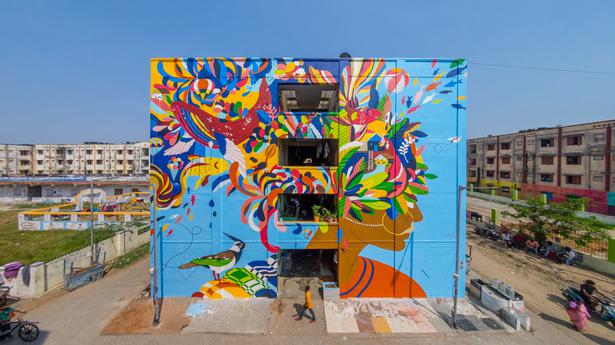
Six more walls in Chennai’s Kannagi Nagar will sport new murals
The Hindu
The neighbourhood comes alive with wall art once again as St+art India’s roster of national and international artists take over six walls
Some may call it surrealist: while serenity washes over a face sporting a nose ring, an explosion of feathers, punctuated by houses in blue, green, yellow, orange and pink fills the facade. Indentations in the form of windows, doors and the occasional crack are the negative spaces of this concrete canvas.
Part of this face today is masked by clothes hung out to dry, as children of the locality play a game of tag, snapping us back to the reality of one of the largest resettlement areas in Tamil Nadu — Kannagi Nagar. Here, as daily life unfolds, yet another wall stands in the background narrating a story through colour.
Kannagi Nagar and its people are now used to the drill. In 2019, before the pandemic struck, St+art India saw the identical apartment buildings as empty canvases. With People and Environment as the theme, artists from across the country and abroad adorned 16 facades in the locality, making it India’s fifth Art District.
From Australian artist Bronte Naylor to Chennai’s own A-Kill and Delhi-based Osheen Siva among others, they captured Kannagi Nagar and the larger Tamil culture in bits and pieces. The initiative supported by Greater Chennai Corporation, Asian Paints and Tamil Nadu Urban Habitat Development Board also aided workshops for the community, culminating in a launch programme where beatboxers, hip hop dancers and gaana singers drew crowds to this otherwise neglected area.
Cut to March 2022, six more walls have been draped in colour as the third edition begins. While the theme remains the same, a new roster of seven national and international artists will take over the walls, all through the month of March.
“The fact that Kannagi is so cut off from the centre of the city, but also is confined somehow in a purely urban level, makes the community bind together stronger. And so, such cultural interventions are more accepted,” says Guilia Ambrogi, co-founder and curator of St+art India. She adds, “The murals have been very contextual right from the beginning, to its environment. How do we make that sustainable and valuable to everyone is the question we are asking ourselves.”
While art workshops have been done in the past, over the course of their work, the team has identified how important dance and music is to the community. Now besides art, workshops pertaining to performance will also be held. Another key focus is on teaching the children about consent.

On December 23, the newly elected office bearers of the Anna Nagar Towers Club, led by its president ‘Purasai’ B. Ranganathan, who is a former MLA, met with Tamil Nadu Chief Minister M. K. Stalin and conveyed their greetings. According to a press release, besides, ‘Purasai’ B. Ranganathan, the Anna Nagar Towers Club delegation that met Stalin at Anna Arivalayam, the DMK Party headquarters, included vice-president R. Sivakumar, secretary R. Muralibabu, joint secretary D. Manojkumar, treasurer K. Jayachandran and executive committee members N. D. Avinash, K. Kumar, N. R. Madhurakavi, K. Mohan, U. Niranjan, S. Parthasarathi, K. Rajasekar, S. Rajasekar, M. S. Ramesh, R. Satheesh, N. C. Venkatesan and K. Yuvaraj. Karthik Mohan, deputy secretary of DMK’s Information Technology Wing, was present on the occasion.












